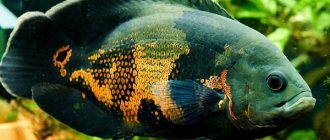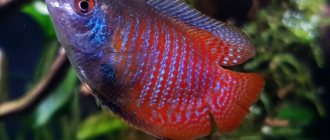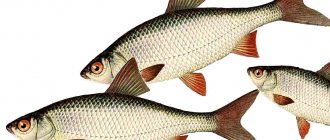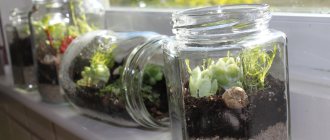general characteristics
Gourami are freshwater fish belonging to the suborder of the sliders of the Osphronema family.
These fish differ from others in the presence of an auxiliary respiratory organ - a labyrinth, which is why they are sometimes called labyrinthine. With the help of a labyrinth, fish are able to breathe air. The labyrinth is a transformed first gill arch. At its widest point there are bone plates covered with mucous membrane and blood vessels. According to the mechanism of operation, the organ resembles the lungs. Thanks to it, fish are able to breathe air in conditions of low oxygen content in the water, and they can also live on land for quite a long time.
The labyrinth develops 2-3 weeks after the fry emerge from the eggs. During gourami spawning, eggs should be provided with water that is well saturated with oxygen.
The body of a gourami is long and flat. The anal and upper fins have an elongated and slightly pointed shape. On the abdomen there are thin thread-like antennae, with the help of which the fish can “feel” the bottom. If damaged, the antennae can grow back.
It has been noted that in aquarium conditions, gouramis can grow up to 12 cm, but more often the fish grow from 3 to 8 cm. These are long-lived fish. It was recorded that the age of one of the oldest gourami was 88 years.
Feed again
At this stage, you need to again prepare food for the fry, again preferably live - Artemia nauplii. You can buy brine shrimp eggs at a pet store or at Ptichka. I usually take a two-liter cola bottle, fill it with ¾ of water, put one and a half teaspoons of regular salt and a teaspoon of brine shrimp eggs, lower it with a spray from the compressor and place it on the aquarium rack, every other day the brine shrimp are hatched, the sprayer is turned off to collect, the crustaceans accumulate at bottom, and they are sucked in with a hose from the compressor. It is better to place 2 bottles with a difference of 2 days, then you will always have nauplii for feeding.
Types and their description
Let's look at the most popular types of gourami in home aquariums.
Pearl gouramis are one of the most beautiful and widely popular species among aquarists. These fish gained their fame due to their bright red-orange color, they have a dark stripe along their body, and small white dots like pearls adorn their scales.
This fish is also known for making unusual sounds during spawning. The pearl gourami does this with the help of its fins. It is believed that this species has a good memory and is even able to distinguish its owner from other people. The lifespan of pearl gourami is about eight years. The fish can reach 9 cm in length.
The marbled gourami attracts the eye with its color. There is a blue design on the blue body. Light dots are visible on the caudal and anal fins. The body length of the male reaches 10 cm, the female is smaller in size. During the spawning of marbled gourami, the pattern on the body of the male becomes much darker than that of the female.
The body of blue gourami is almost monochromatic, but in some places there are dark spots on the scales. These fish shine beautifully in the light.
Kissing gouramis are famous for their unusual lip shape. When the fish meet and start communicating, it may seem like they are kissing. The body of these fish is colored pink and light green, and the fins are transparent. Kissing gouramis grow large in captivity: up to 15 centimeters, and therefore they need a fairly large aquarium. In nature, they can reach 30 cm, and therefore are quite often eaten. Another feature of this type of fish is its bad character, which makes it difficult for them to find neighbors to live together.
What does a gourami look like?
This is a charming fish with an elongated body, slightly compressed from the sides. Its dimensions are small; in aquariums you can rarely find an individual larger than 10 cm; in nature, some species can be 20-25 cm long.
The dorsal and pelvic fins stretch along the entire body, expanding slightly towards the end. The structure of the pectoral fins, which gave the Latin name to the genus - Trichogaster (“thread from the belly”) or Trichopodus (“thread-legged”), is unique: instead of the usual fins, gourami have long thin threads growing in front, which are a tactile organ.
First appearance in aquariums
For a long time, gourami could not be taken out of their habitat for the purpose of distribution in aquariums. Several times they tried to transport the fish in barrels filled to the brim with water. Not a single fish survived the move. It has long been believed that these fish are unsuitable for transportation.
Everything changed at the end of the 19th century. One of the scientists noted that in nature these fish periodically emerge from the water to swallow some air. He suggested not filling the barrel with water to the brim. As a result, they tried to transport the fish in a barrel two-thirds filled with water. In 1896, for the first time, it was possible to successfully transport gourami, and not a single fish died. Soon, gouramis, as easy-to-keep and easy-to-breed fish, became widespread in aquariums all over the world.
Pearl gourami care and maintenance
Aquarium.
To keep this species, you must have an aquarium with a capacity of more than 50 liters. This volume is enough for 6–7 pieces (for 1 male you need 2–3 females). If the aquarium has a lid, it should not fit tightly as air needs to be constantly circulated. For a layer of soil (5–6 cm), take coarse river sand, the structure of which is suitable for algae growing in the aquarium.
Vegetation.
These small fish like to hide and build their nests in thickets, so lush, bushy vegetation is suitable for keeping them: elodea, vallisneria, pinnate.
Don't use too many plantings, give them room to float.
You can spread duckweed on the surface, collecting it into islands. Just watch out for its growth: it should not cover the entire surface of the water so that the fish have access to air.
Water parameters.
Gourami love warmth, so be attentive to the temperature of their habitat. It should be 24–27°C, otherwise the fish may get sick. It is best if the aquarium is equipped with a heater with a thermostat. Try to change the water regularly (25% of the aquarium volume per week).
Compatibility.
Keeping them with other species can be problematic. But the point is not in the character of gourami; they cannot be called fighting ones. The point is the neighbors, who may be attracted by their worm-like fins. If you still want to add other fish to them, find out if they are aggressive or predatory, otherwise the gouramis will not get along with them. Such unwanted neighbors include swordtails, barbs, some species of cichlids and characins.
GURAMI CARE CONTENTS DESCRIPTION SPAWNING COMPATIBILITY.
Natural habitats
Gourami got its distribution from Southeast Asia and the adjacent islands. The first aquarium fish were caught in Vietnam, Malaysia and Thailand. Different types of gourami live in different areas.
In nature, they live in standing and flowing reservoirs of various sizes. Brown and spotted gouramis live in brackish estuaries and tidal zones.
Nowadays, some species of gourami are listed in the Red Book, while others are completely bred in aquariums and are not found in nature.
Feeding
Gourami fish are unpretentious in terms of feeding. They can be given dry, live and artificial food. The basis of the diet should consist of artificial flakes and granules. You can supplement the diet with frozen and live food: bloodworms, crustaceans, insects, dry and live daphnia, and tubifex.
These fish have a small mouth, so it is advisable to grind the food before feeding. Adult gourami can withstand a hunger strike for 7-14 days, so they can be safely left without food during the holidays.
Preparing starter feed for feeding fry
It is necessary to stock up on food at this stage, since it is better to feed the fry with live food. Since gourami fry are small, they eat ciliates first. So, take a jar, preferably three liters, siphon the soil in your aquarium and pour this water into the jar - there are always ciliates in an old aquarium! Add some dead parts of plants, a teaspoon of milk, a 1 by 1 cm piece of dry banana peel and place the jar in a bright place. At first the water becomes cloudy, then it brightens and clouds of ciliates are visible even to the naked eye. It is convenient to select them using a hose from the compressor.
Content Rules
Gouramis are happy timid fish, so the soil must be densely populated with algae so that the fish can hide in it. The optimal temperature for fish is 24-28 degrees. It is important that the water and air temperatures are the same. If the air temperature is much lower, the fish may freeze its breathing apparatus. Acidity pH - from 6.5 to 8.5.
To achieve the most vibrant color, it is necessary to create bright lighting in relatively dark soil.
Gourami do not need highly oxygenated water. However, it is still advisable to install an aerator. Its power should not be made large so as not to create currents, because gourami in nature usually live in stagnant water.
The fish must have access to air, and therefore you should not plant the aquarium with a large amount of swimming algae. However, they are necessary so that the male can create a nest during spawning.
Gourami need space to play and swim. Gourami can be kept in small flocks. There should be three females for every male. An aquarium with a volume of one hundred liters should be enough for six individuals.
These fish are capable of jumping high, so a lid for the aquarium is necessary. However, labyrinth fish breathe air from the surface, which means there must be good ventilation under the lid. The distance between the lid and the water should be at least 5 cm.
What to feed the fry
The fry do not need food for another 3–4 days, feeding on the contents of the yolk sac. They will then require external feeding. Meals can be provided 5-6 times a day, the portions should be small.
Food for gourami fry can be as follows:
- Rotifer.
- Ciliates.
- Liquid food for fry.
- Hard-boiled egg yolk, pureed through cheesecloth.
After just a few weeks, the fish can be transplanted into a common aquarium, while adding protein-rich food to their diet - it will help the scales develop correctly and add brightness to the color.
Sex differences
Gourami have clearly expressed sexual dimorphism, so even an amateur can distinguish a male from a female. Females have shorter fins and have a rounded shape. They have a round and wide body. In males, the fins are pointed, and the upper fin can reach the length of the tail. Males have a larger body than females. It has an elongated, pointed shape. Males are much brighter than females.
During spawning, gourami males become much brighter in order to attract the attention of the opposite sex, while females remain dull and inconspicuous.
How to distinguish a female from a male
To select fish for breeding, it is important to be able to distinguish the different sexes from each other.
You can determine gender by appearance:
- Boys are different in that they are larger and more active. Females are slightly smaller, their body is dense, and the tummy of mature individuals becomes rounded.
- The female is also distinguished from the male by the type of dorsal fin. She has a rounded shape, while in males it is pointed.
- There are also differences in color: males are bright, females are duller. Before spawning, pigmentation intensifies, and males become even more recognizable - this helps determine the sex of gourami with high accuracy.
Setting up the spawning tank
It is not difficult to spawn gourami at home. As a spawning tank, you should choose an aquarium with an approximate volume of 40-80 liters, filled with 15 cm of water. The small size of the aquarium and low water level usually have a positive effect on gourami reproduction, but there are exceptions. There are species that require a fairly large spawning tank: kissing, blue, pearl gourami, and species in which the adult size reaches more than 25 cm.
Most gourami species create foam nests in the leaves of waterfowl. For other species it is necessary to provide shelters.
The filter should not be very powerful so as not to damage the eggs.
Preparing the spawner
As a spawning tank, it is better to take an aquarium with a volume of 30 liters. There should be shelter for the female, personally I use ceramic driftwood; floating plants - for me it’s usually pistia, you can add a few branches of nayas or hornwort. We put a heater in the spawning tank - the temperature should be about 25 degrees. The water in the spawning area can be softened, which will serve as a stimulus for spawning. Water should be poured into the spawning tank at the rate of 50% water from the aquarium and 50% water from fresh, settled water.
Breeding
A photo of gourami spawning is presented below.
First, the male is transplanted into the spawning tank. It is necessary to gradually raise the temperature to 29 degrees. The male begins to build a foam nest in the thick of floating algae.
Afterwards, a female with a rounded abdomen full of eggs is placed in the spawning tank. A skinny female, not ready for reproduction, can be driven to death by the male. If the female is ready to breed, the male begins to court her. It changes a lot in color - it becomes much brighter.
Gourami spawning in an aquarium is a truly unusual and interesting sight. The male invites the female to the nest, and there, clasping the female with his body, he turns her over with her belly towards the nest. The male squeezes the female tightly, squeezing out the eggs and fertilizing them at the same time. Afterwards the male releases the female. He collects the eggs in his mouth, and then places them in a foam nest. The process is repeated several times.
When the female is completely drained, the male becomes aggressive and continues to pester her. The spawning ground must have algae in the water column, in which the female can hide from the male. Since the male jealously guards the nest, after the gourami spawns, the female must be removed. Otherwise, the male will strongly pluck the female and chase her away.
When does puberty occur?
Representatives of the species reach full sexual maturity at approximately 8–12 months of age. It will not be possible to get offspring earlier.
When favorable conditions are created, the female is capable of spawning approximately 4–5 times per season. Between each birth of offspring, a break of several weeks is required.
It is important that gourami have the opportunity to rest and fully recover after having offspring.
Caring for fry
The male takes care of the eggs and valiantly performs his duties. If an egg falls out of the foam, he carefully returns it to its place. After two days, larvae emerge from the eggs. It will take another three days for the larvae to become fry. During this period, it is important to monitor the water temperature, because if it decreases, the male may well destroy the nest and eat the larvae.
While the fry cannot swim on their own, the male monitors them and helps them swim to the surface. After the babies learn to swim on their own, the male can be returned to the community aquarium. It is very important not to miss the right moment, since the fry, spreading in different directions, which no longer need their father’s care, irritate the male so much that he may well eat them.
The fry can be initially fed with ciliates and later slowly switched to zooplankton. If the fry grow at different rates, it is advisable to remove larger individuals so that they do not eat small fish.
Thus, gouramis are very beautiful and easy to keep fish. They are unpretentious in food, and even a beginner can reproduce them. This is why these aquarium fish are so popular in home aquariums.
Raising gourami fry
After spawning, it is better to immediately remove the female, otherwise the angry father, protecting his nest and offspring, may take out his aggression on her. The male gourami actually raises the fry. The eggs stay well in the foam nest, but if they suddenly go to the bottom, the male immediately reacts and returns them back. After a day or two, the fry hatch. The incubation time depends on the water temperature, which must be constantly monitored: if the male senses something is wrong, he can stop caring for the fry and destroy them. Also during this period he is not given any food. The father is left in the aquarium until the offspring learns to calmly swim around the aquarium. The hungry dad “moves” back to the common aquarium, the nest begins to collapse without him, but the little gouramis no longer need it. Gourami fry should be fed ciliates and zooplankton.
Reproduction of pearl gourami, one of the most beautiful species, is a little more complicated. During the spawning period, it is recommended to be very sensitive to what is happening in the spawning area and under no circumstances disturb the fish.
Reproduction of other varieties - marbled, blue, honey, etc. gourami follows the same scenario.
PEARL GURAMI Characteristics of external features
This fish has a fairly tall body; the shape of the pearl gourami is flatter in the lateral area and extends in length. The body of the fish has a magnificent silver-violet color, various pearlescent spots are located throughout the body and fin area, and a dark stripe stretches along the body. The name of this fish is due to the presence of spots, since they closely resemble pearls. The length of the fish is eleven centimeters. Female pearl gourami are smaller in size than males and have a light coloration. Compared to females, males have a more elongated dorsal and anal fin. The chest and abdomen of males have a bright red-red color during the spawning process.
PEARL GURAMI Habitat Features
Pearl gouramis have unique beauty ; they have a peaceful and quiet temperament, but the fish are quite shy. They live comfortably in an aquarium with fish of various species and calm in nature. Providing comfortable living conditions for these fish is quite simple, since they are unpretentious. A convenient aquarium for pearl gourami will be a reservoir of 40 liters or more in volume, filled with many plants and all kinds of shelters that the fish need so much. Dark soil will also be most pleasant for them. Do not forget to leave free space for the fish in the aquarium where they can swim, and it is also important to maintain clean water and natural light. For these fish, the following water parameters are comfortable: temperature in the range from 23 to 27 degrees, hardness no more than 16°, and pH 6.0-7.0. Once a week, the water should be filtered and aerated, and at least 30% replaced. Bloodworms, tubifex, daphnia, that is, live food, are suitable food for pearl gourami; however, dry food is also suitable for feeding fish.











